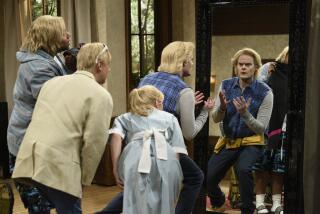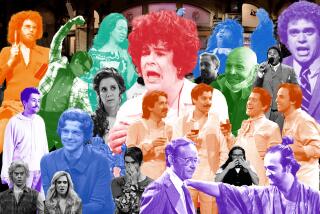A ‘Simpsons’ Achiever--And He’s Proud of It
- Share via
FULLERTON — As a college dormitory director in Maine, then Missouri and now at Cal State Fullerton, Roger Scranton had long ago learned the one immutable facet of the academic calendar: “Thursday night is not a study night,” he sighs. “Thursday night is ‘Simpsons’ night.”
At his last job, at Central Missouri State University, Scranton estimated that half his students closed their books at 8 p.m. every Thursday to revel in the misadventures of the lowbrow cartoon family. And if there had been any doubt that Fullerton held a similar interest in the cartoon high jinks, they were dispelled by the first visiting lecture sponsored by the Associated Students organization.
The guest, hired at a cost of $1,200: “Simpsons” producer David Silverman, who supervises animation for the Fox television comedy.
Sporting a bootleg Simpsons-as-Rastafarians T-shirt, Silverman addressed a rapt audience of 120 crowded into a dormitory conference room Tuesday night. He told of his migration from Long Island, N.Y., to UCLA, his days as an art student and his work on such films as “One Crazy Summer” before landing a job animating 17-second “Simpsons” shorts for “The Tracey Ullman Show” in 1987.
Frequently--and seemingly involuntarily--breaking into the cartoon voices of Homer Simpson, Krusty the Clown and other characters normally portrayed by voice actors, Silverman retraced the evolution of the cartoon clan. On an easel, the 34-year-old animator drew the early versions of Bart and Homer that he received from “Simpsons” creator Matt Groening. Students gasped as they saw a less-bald, taller Homer and a Bart with an even pointier coiffure.
Silverman said that Groening, who also draws the underground comic strip “Life in Hell” and markets irreverent greeting cards and calendars, had readily admitted that he was not an animator. Making the paradigmatic Middle American family come to life would fall to Silverman and his colleagues, he said.
Silverman then showed 45 minutes of cartoons, beginning with his surreal UCLA student film “Marinerman” and continuing through early, Ullman-era “Simpsons” work before reaching more recent clips from the weekly half-hour program. He included footage of the disorderly animation studio where he works and showed the process by which scripts become storyboards and storyboards cartoons.
When Silverman paused to take questions, though, Fullerton students had a chance to reveal the depth of their “Simpsons” studies.
Their inquiries ranged from the technical (“How many cels are used for a single episode?” Answer: 12,000 to 20,000) to the academic (“Have you ever done investigations into the nature of the humor you use?” asked one student. “Naaah,” the reply.)
And one student even took the program to task for a perceived “political correctness.”
“ ‘The Simpsons’ parodies some ethnic groups,” said William Nakashima, 21, “but you stay away from others. You’ve got Apu the Indian running the Quik-E-Mart, and the Japanese at the sushi restaurant, but you never make fun of blacks or Hispanics. The only black character on the show, Dr. Hibbert, is a figure of reverence and is never parodied. Is there some kind of unwritten rule here?” Nakashima, a finance major, demanded.
Silverman responded by miming a tightrope walker. Then he added, “Doing stereotypical things might be perceived as racist. It comes down to the point where choosing the colors of characters is a political act for us; we can’t make certain characters African-American, because that might be seen as insensitive.”
Silverman said that producers felt that poking fun at Asians and subcontinental Indians was less socially divisive. “Is that a compromise?” Silverman said. “I guess it is. There you go, pal.”
Despite his critique, Nakashima confessed to be a “Simpsons” fanatic, having memorized such esoterica as the intersection by which Homer’s boss, the Scrooge-like Mr. Burns, lives (Croesus and Mammon streets).
Not all present, however, were fans of the cartoon program.
Jorge Morales, who works for a Santa Ana gang violence prevention program, said he came to “learn the ideology of the person who developed this program.”
Morales noted that Bart Simpson evinces considerable self-esteem but said the mischievous 10-year-old cartoon character provided a poor role model for youth.
“ ‘The Simpsons’ shows kids not doing their homework and being disrespectful of authority,” said Morales, 26. “And the kids I work with, they try to imitate that.”
Curiously, many of the Fullerton students said they reacted the same way.
“I wish I was Bart Simpson,” said Christi Graham, 18. “He’s such an anti-authority figure who gets away with everything,” she said, noting that her high school in Riverside had banned “Simpsons” novelties, such as the Bart T-shirt that proclaimed “Underachiever and proud of it.”
Added Coby Gewertz, 19, who brought a 6-foot-tall cutout of Bart Simpson for Silverman to autograph: “ ‘The Simpsons’ are unstoppable. Can’t touch Bart.”
But it was Mike Gibbons, 34, a graduate student in sociology, who put the runaway cartoon hit in its proper scholarly perspective.
“I view it as kind of a warning to parents of how not to raise a family, he said. “ ‘The Simpsons’ hits hard on certain sociological issues and perfectly brings them to light. And the show is filled with hidden meanings that bear repeated viewings and really inspire you to think,” he said, in reference to the program’s subtle homages to “Citizen Kane,” the Algonquin round table and other sophisticated cultural images that rarely surface in other cartoons.
And even Scranton, the dormitory director who weekly witnesses “The Simpsons” induce another round of procrastination among his charges, allowed that the eight-fingered animated family was not all bad.
“I’m not a regular watcher,” he insisted. “But I do like all those crazy situations Bart gets into.”
More to Read
The complete guide to home viewing
Get Screen Gab for everything about the TV shows and streaming movies everyone’s talking about.
You may occasionally receive promotional content from the Los Angeles Times.






